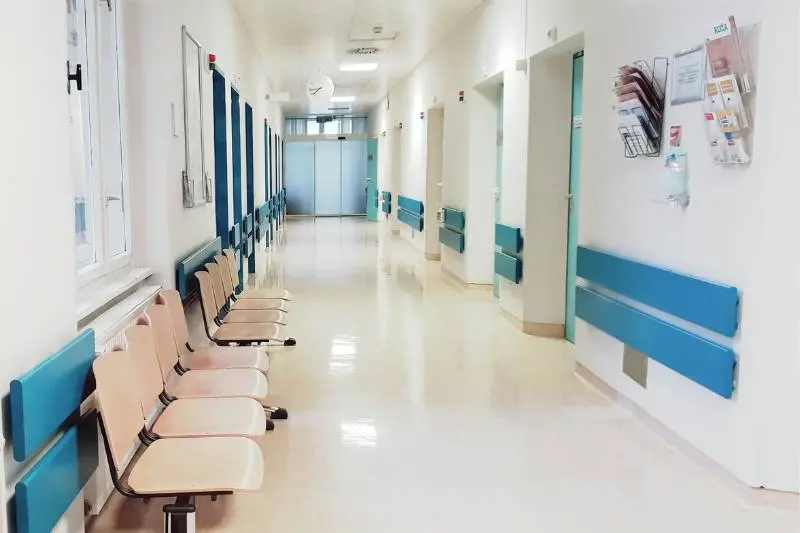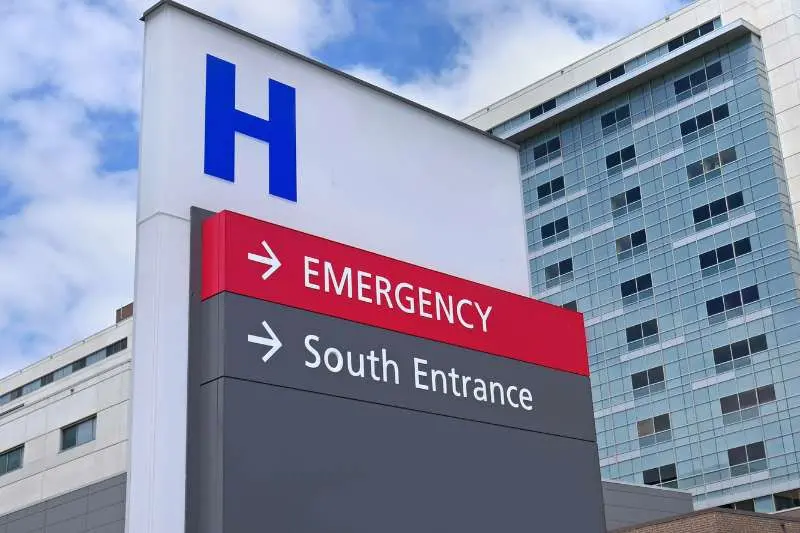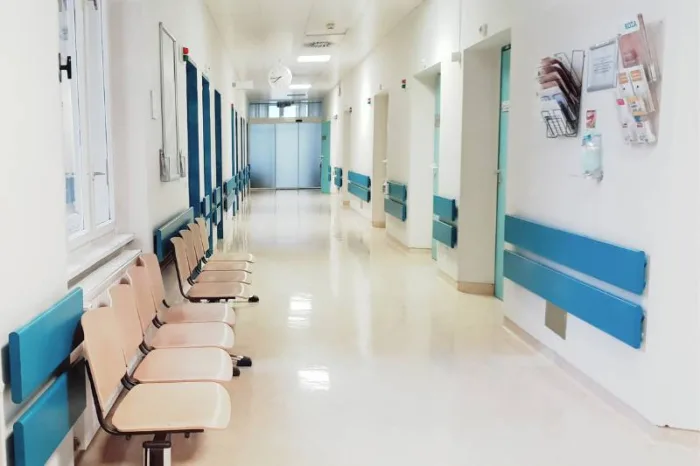Key takeaways
- Hospital access control aims to protect people, data, and resources.
- Healthcare facilities face unique challenges, such as securing multiple entryways and exits, being accessible 24/7, and housing targets at high risk of theft.
- Dentist offices, memory care units, and pharmacies also require healthcare access control.
- When implementing a new access control system, consider your facility’s needs, ensure it complies with industry regulations, and establish a clear hospital access control policy.

Hospitals and other healthcare facilities face unique security challenges that require a robust solution. Fortunately, healthcare access control systems enable healthcare facilities to provide patients with the care they need safely and securely.
With that said, this guide will detail why access control is crucial for healthcare facilities. In addition, you’ll learn what role-based access control is, how it’s used in hospitals, and how much these types of solutions cost. Above all, discover what the best hospital access control system is on the market.
This post covers:
- Why is access control important in healthcare?
- Unique challenges of hospital security
- Types of healthcare access control
- Healthcare access control examples
- How to implement a new access control system at your hospital
- How much does an access control system cost?
- Choosing your hospital access control system
Why is access control important in healthcare?
Access control in healthcare manages who can access certain spaces, resources, and data within a hospital or other healthcare facility. Additionally, it’s used to protect people, such as doctors, nurses, and patients.
Healthcare access control is important because it aims to maintain a safe and secure facility for medical professionals to perform their duties. After all, hospitals, dentist offices, and other healthcare facilities aim to treat and care for patients as effectively as possible.
An access control system supports the goal of hospitals by protecting three primary things:
1. People
Patients, visitors, doctors, nurses, custodial staff, and numerous others are the primary reasons for hospital access control. While these systems are meant to protect individuals, they also restrict their movement through the facility.
Limiting people’s access lowers the risk of security issues, including unauthorized entrants and aggressive patients. Without proper credentials, these individuals cannot carry out their motives while also reducing the number of people they could potentially harm.
2. Assets
Healthcare facilities spend millions of dollars on medical equipment and supplies yearly, meaning safe and secure storage is paramount. However, according to the Healthcare Crime Survey by the IAHSS Foundation, theft is the third most common crime reported in hospitals.
3. Data
Finally, healthcare organizations must adhere to stringent HIPAA regulations governing Protected Health Information (PHI), emphasizing patients’ federal rights over their health data.
The security of patient information requires two approaches: cybersecurity and physical security. While most think data is stolen through cyberattacks, there are many instances where the lack of physical security or vulnerability is to blame. For example, a physical credential could be stolen or copied to gain access to sensitive patient data.
In any case, your hospital’s access control system should leverage mobile access control technology. This innovative approach minimizes the reliance on traditional physical credentials like key cards or badges, which can be susceptible to theft or duplication. Adopting a mobile access control system enhances your facility’s security and reduces the potential for breaches. As a result, you also fortify patients’ overall data protection.
Unique challenges of hospital security
The nature and design of healthcare facilities make implementing a robust security solution challenging.
More specifically, hospital security includes the following challenges:
- Multiple entryways and exits. Hospitals are designed with various entryways and exits for the public, employees, contractors, staff, delivery drivers, and more, creating a complex need for secure access points.
- Public and private areas. Generally, hospitals are open to the public, allowing anyone to access the facility, so hospitals should secure the most sensitive areas from the public by only granting access to authorized employees.
- Security Sensitive Areas (SSA). A Security Sensitive Area (SSA) is a place in a hospital that requires more security because of the assets stored there or the nature of work performed. These areas may include emergency rooms, maternity wards, and office spaces, which require a higher level of security.
- 24/7 access. With 24/7 access to the public, your hospital has a sporadic and inconsistent schedule, meaning your facility should be equipped with an access solution that can flex to those needs.
- High-risk targets. With such high-risk targets in your facility, from patient records to medication and expensive equipment, access control systems provide additional hospital security to secure these assets.

Types of healthcare access control
There are two types of access control in healthcare facilities: physical and logical. The difference between these two is in what they manage access to.
Physical access control refers to managing who can enter and exit parts of a facility. These access control systems allow people to enter specific areas using credentials such as a key card, fob, smartphone, or PIN.
Conversely, logical access control manages access to digital resources such as data, applications, and network systems.
Healthcare facilities require both types of access control as they are highly sensitive areas with people and valuable resources. Meanwhile, they must uphold patient data privacy per HIPAA security guidelines, making access control a critical component of any hospital.
What is role-based access control in a hospital?
Role-based access control (RBAC) restricts access to certain areas based on a hospital employee’s role. That way, only designated roles may enter authorized areas, preventing individuals from entering areas that are irrelevant to their position.
For example, licensed practical nurses (LPNs) cannot prescribe medicine to patients. Instead, they offer more direct patient care by assisting with daily activities and checking blood sugar or blood pressure. So, LPNs should not have access to areas where medicine is stored. This lack of access should be reflected in the access control system when roles are created.
Conversely, registered nurses (RNs) can prescribe and administer medications orally or through an IV. So, RNs’ roles in the access control system grant them access to areas where medicine is stored.
Overall, role-based access control is designed to make access easier for hospital employees. If an employee is promoted, they may need access to additional areas. In that case, all you need to do is assign them a new role in the system.
What are the other types of access control for healthcare facilities?
There are a few other types of access control relevant to healthcare facilities. Please note that access control can also refer to permissions and restrictions for computer software and data protection, which we don’t cover in this post.
The other types of logical healthcare access control are:
- Attribute-based access control (ABAC). These systems base access permissions on time, location, and a user’s role. For example, after-hours permissions at your facility will change who is allowed onto your property, such as night or janitorial staff.
- Physical access control. We’ve reviewed physical access control earlier in this post. Physical access control takes the form of physical devices that restrict access, such as turnstiles, locks, and gates. Additionally, this is a good time to mention that access control systems can have multiple classifications. ABAC access control can also be physical access control and role-based access control.
Learn how to set up access groups at your hospital using ButterflyMX:
Healthcare access control examples
While hospitals are the biggest examples of access control in healthcare facilities, they are not the only organizations that require such security measures.
Examples of healthcare access control include:
Dentists and doctor’s office
Doctor’s and dentist’s offices seem like an unassuming corner of the healthcare industry, but both house expensive equipment and pharmaceuticals that need protection.
Not to mention, these healthcare offices receive many visitors every day while closing overnight. So, it’s vital these businesses protect their assets with a robust access control system.
Memory care and nursing homes
Memory care units and nursing homes have the same challenges as the other healthcare access control examples on this list. However, they also have the added challenge of preventing patients from wandering, which is a common symptom of those with dementia. It’s up to the nursing home’s access control system to prevent these individuals from exiting the facility or entering areas where they could harm themselves or others.
Pharmacies
Pharmacies need access control systems to protect the vast amount of pharmaceuticals available at their facilities. Drugs are a factor in crime, so pharmacies need extra security measures.
A good access control system will ensure that only trained staff members can access restricted areas and allow you to review everyone who has accessed them at your pharmacy.
How to implement a new access control system at your hospital
Introducing a new access control system to your healthcare facility can cause major disruptions if you’re unprepared. So, we’ve compiled some tips to help you prepare your facility for a smooth transition.
When implementing healthcare security access control, you should:
- Conduct a thorough security assessment. Work with a security installer or integrator to evaluate your facility’s infrastructure. They’ll help you identify high-risk areas and potential vulnerabilities that an access control system can help protect. A thorough assessment will establish a solid foundation for an access control strategy.
- Ensure regulatory compliance. You must choose a system that complies with regulatory requirements such as HIPAA. Make sure to hire an integrator who deeply understands these requirements. This way, you’ll have a better experience adhering to guidelines and reduce the risk of hefty fines or penalties.
- Choose the right solution. Choosing the right solution is one of the most vital steps in implementing a new healthcare access control system. Many options are out there, but they won’t all be designed to meet your facility’s needs. With the help of your installer, determine what features and capabilities your system will need before making a decision.
- Provide healthcare access control training. No matter how simple the system is to use, you should provide training for all access control users at your property. You want to ensure that your staff and users clearly understand how the system operates.
- Establish a hospital access control policy. Implement clear policies regarding who has access to specific areas of your hospital and under which conditions. You can establish access roles or levels within the system’s operating system.
How much does an access control system cost?
On average, an access control system costs anywhere from $2,000 to more than $10,000.
Of course, many factors influence the price of an access control system — especially for hospitals. It’s also important to mention that the cost of the system does not include installation, ongoing maintenance, or subscriptions.
Generally, hospitals can expect access control system costs to fluctuate based on:
- Type of system
- Features
- Number of access points
- System manufacturer
- Dealer
Choosing your hospital access control system
When you’re choosing the access control system for your hospitals and other healthcare facilities, go with ButterflyMX.
Established in 2014, ButterflyMX is a cloud-based access control company. With more than 15,000 building installs and 40,000 five-star reviews, ButterflyMX offers a property-wide access control solution that meets your hospital’s unique needs.
ButterflyMX enables users to access areas with their phones, reducing the need for physical credentials. However, our access control platform also supports key cards, key fobs, and PIN codes — all manageable through any device.
The ButterflyMX Access Control ecosystem includes:
- Keypads. ButterflyMX Keypads accept various credentials, such as a PIN code, key cards, and fobs. Additionally, our Keypads accept access through the mobile app for a touchless solution.
- Card readers. Like our Keypads, the Readers accept key cards, fobs, and the mobile app.
- Vehicle Readers. Perfect for garages and parking lots, Vehicle Readers simplify vehicle access by scanning the Windshield Tag and granting access. Vehicle Readers are ideal for employee parking garages and areas where vehicle access is restricted.
- Elevator Controls. Control employee and visitor access to certain levels of the hospital by enabling Elevator Controls. That way, you can prevent unauthorized personnel from entering sensitive floors.







